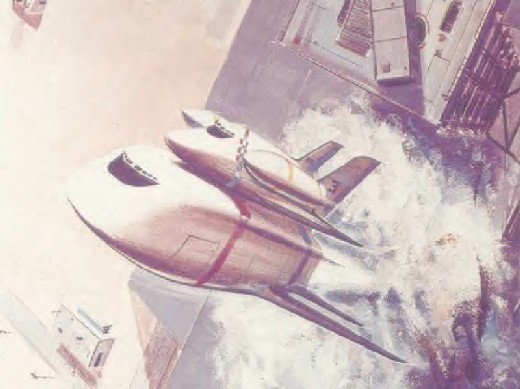
 |
 |
 |
 |
 |
 |
 |
 |
 |

The huge wing tanks (which carried 54,011kg of LH2) had the effect of increasing the orbiter’s “propellant fraction”, in other words the shuttle’s empty weight would be less despite carrying more propellant at liftoff. Not only did this produce a smaller and less expensive orbiter, it also enabled Boeing to simplify the booster as well. The system would now stage at a lower velocity (2123 meters/sec.) than the fully reusable Phase-B design’s 3000m/s. As a result, the booster would have to carry less rocket propellant for ascent and 50% less jet fuel for its flight back to the launch site. The lower staging velocity also meant the booster’s thermal protection system could be simplified and Boeing settled for a simple aircraft-like “heat sink” design much like the old X-15’s. The total gross liftoff weight was reduced by 590t compared with the Phase-B baseline shuttle, and it was expected that the marginal cost per flight would stay the same since the additional cost of the fuel tanks would be offset by the reduction in complexity & size (e.g. smaller engines to refurbish between flights). The Grumman orbiter version depicted here has three small engines unlike the NAR & McDAC Phase-B designs. Grumman decided that three 1,845.75-kilonewton thrust engines rather than two 2.45KN-thrust motors would act as a safeguard against engine failure. The Phase-B design had no such problems since it would stage at a higher velocity and still could make it to orbit despite the failure of a single engine.
Although Grumman & Boeing felt a parallel orbiter/booster development program would be the most cost effective option, the contractors also proposed a staggered schedule where the H-33 shuttle orbiter would be developed first. It would initially be launched by an expendable S-IC rocket derived from the Saturn V moon rocket visible at far left. The fully reusable Boeing shuttle booster would later be introduced. The Grumman/Boeing H-33 shuttle is considerably smaller than the North American Rockwell and McDonnell-Douglas fully reusable Phase-B shuttles.
Designer: Grumman/Boeing
Liftoff Thrust: 2,258,500 kg.
Total Mass: 1,963,916 kg.
Core Diameter: 10.0 m.
Total Length: 90.0 m.
Stage Number 1:
--Gross Mass: 1,489,717 kg.
--Empty Mass: 224,431 kg.
--Thrust (vac): 2,546,578 kg.
--Isp: 442 sec.
--Burn time: 216 sec.
--Isp(sl): 392 sec.
--Diameter: 10.0 m.
--Span: 54.1 m.
--Length: 74.7 m.
--Propellants: Lox/LH2
--No. Engines: 12
Stage Number 2:
--Gross Mass: 474,199 kg.
--Empty Mass: 100,153 kg
--Thrust (vac): 1846.75KN.
--Isp: 459 sec.
--Burn time: 234 sec.
--Isp(sl): 359 sec.
--Diameter: 8.1 m.
--Span: 29.6 m.
--Length: 47.9 m.
--Propellants: Lox/LH2
--No. Engines: 3